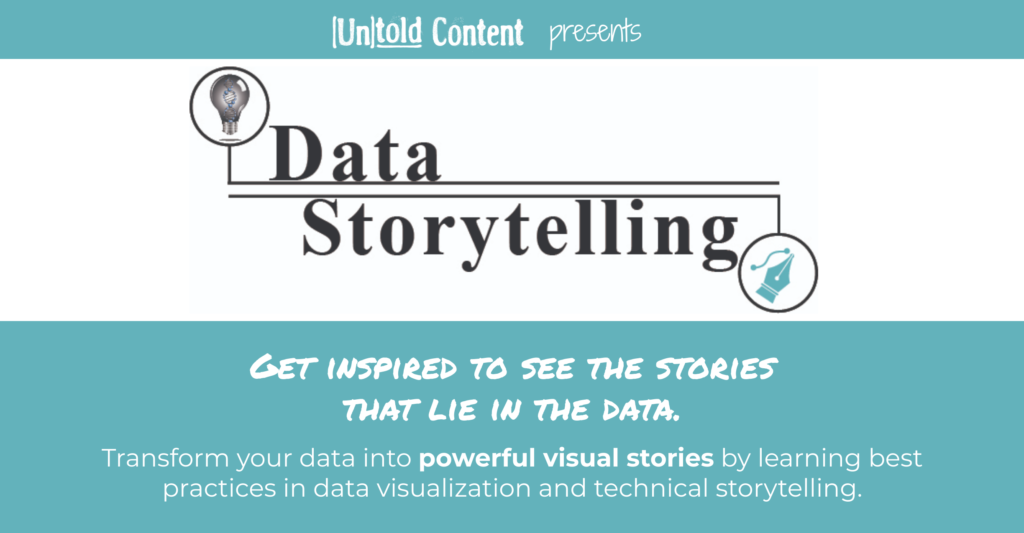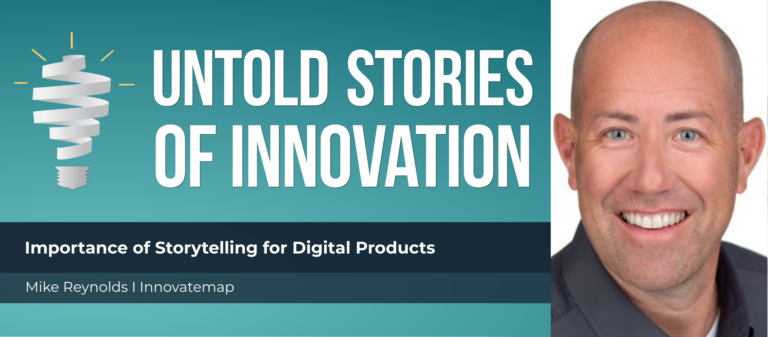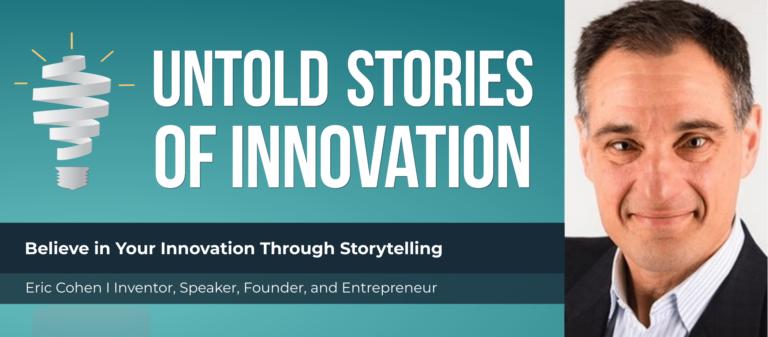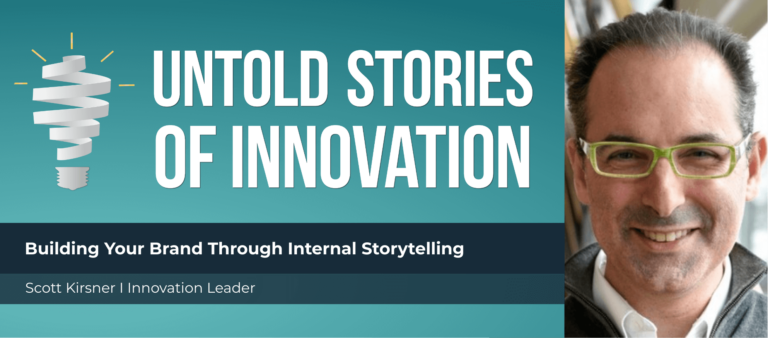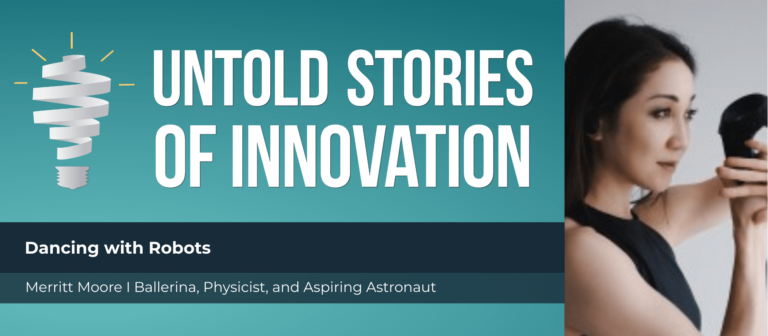Lifelong Learning + Open Innovation to Transform Culture with Steve Rader of NASA
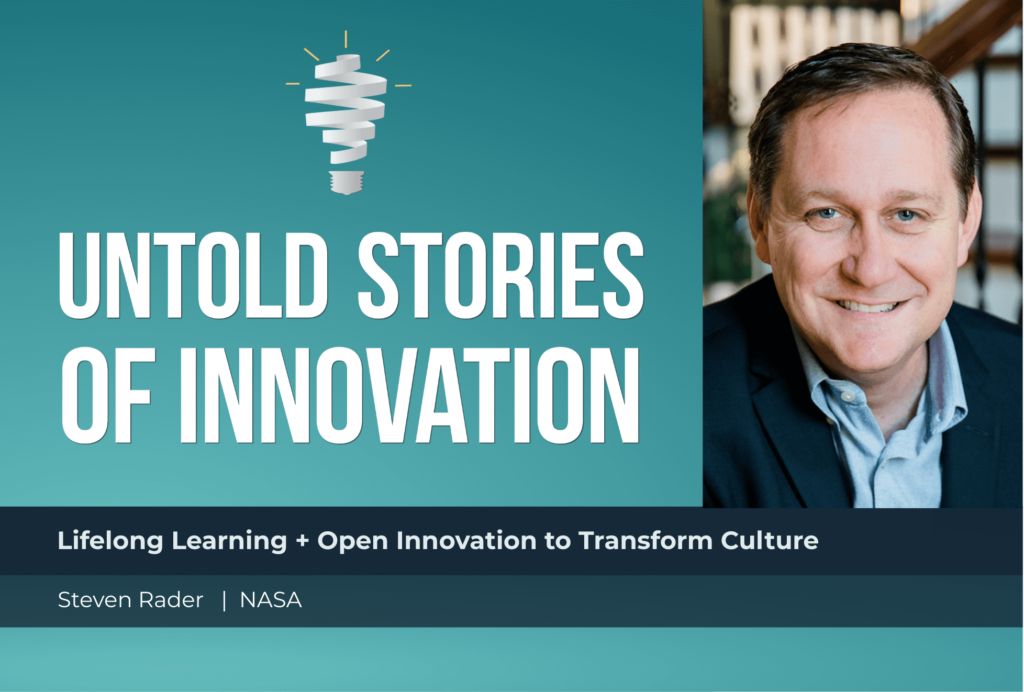
Untold Stories of Innovation
“With open learning and lifelong learning, people can explore their interests and then start to stitch them together in ways that really are the engine behind innovation.” —Steve Rader, deputy director for the Center of Excellence for Collaborative Innovation at NASA
From today’s episode you’ll learn:
Why do stories matter to the innovation process? What values can be instilled in innovators who share stories? How do innovation leaders inspire creators to tell and share their success and failure stories?
Steve Rader, deputy director for the Center of Excellence for Collaborative Innovation at NASA, says storytelling is key to everything he does. He tells us thought-leading organizations will quickly become irrelevant if they don’t utilize open innovation tools as the freelance economy grows. Despite the data-backed benefits of open innovation, the idea was not widely embraced when it rolled out. Steve shares with us how storytelling allowed him to gain internal buy-in and create comfort with disruption on an organizational level. Not only did storytelling play a role in motivating individuals to embrace this change, but it inspired a culture of innovative thinking. Discover open innovation opportunities with NASA.
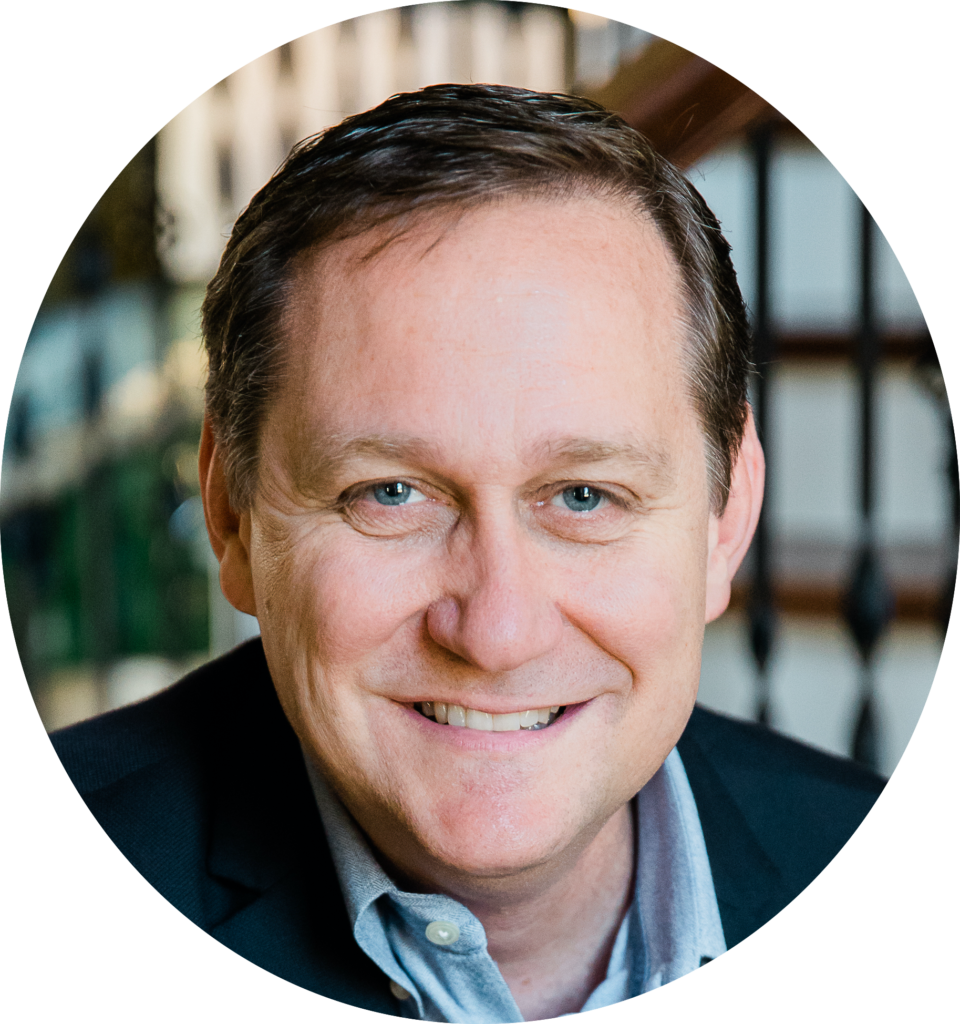
Steve currently serves as the Deputy Director of NASA’s Center of Excellence for Collaborative Innovation (CoECI), which is working to infuse challenge and crowdsourcing innovation approaches at NASA and across the federal government. CoECI focuses on the study and use of curated, crowdsourcing communities that utilize prize and challenge-based methods to deliver innovative solutions for NASA and the US government.
This episode is powered by data storytelling training from Untold Content and Data+Science. Transform your data into powerful visual stories by learning best practices in data visualization and technical storytelling. Whether you’re just looking to find the Best data analysis and data science books, want to learn how to utilize data in a storytelling way, or are just interested in learning more about the topic, this podcast is perfect for you. Many businesses don’t realize that the way they use their data can make or break their growth and improvement. This workshop will inspire you to see the stories that lie in the data. Learn more at untoldcontent.com/data-storytelling-training.
Katie [00:00:00] Our guest today is Steve Rader. He is deputy director for the Center of Excellence for Collaborative Innovation at NASA. Steve, I’m thrilled to have you on the podcast.
Steve [00:00:11] Oh, thank you, I am so happy to be here.
Katie [00:00:14] You’ve worked for NASA for twenty-seven years. Have you always worked in innovation? And if not, what led you to the innovation aspects of NASA?
Steve [00:00:26] Yeah, I started as a flight controller on the space station in life support and moved over to software and systems engineering and communications. I’ve kind of moved around the agency and I would say I’ve always been kind of one of those idea guys. The annoying idea guy. But then I would say—you know what, in 2009, I started really getting interested in open innovation. I read Jeff Howe’s book on crowdsourcing, who kind of coined the term and—
Katie [00:01:00] Yes.
Steve [00:01:00] And saw what was possible and it just lit up my brain. I immediately went out and joined a bunch of communities and tried to really understand what was driving people to do this kind of thing, to participate, and just really got engaged in that and haven’t looked back.
Katie [00:01:22] So open innovation, how long has that been alive and well at NASA?
Steve [00:01:28] Well, at NASA, we had a couple of senior managers that started toying with it and kind of learning about it and doing some benchmarking with companies and they saw what was going on with it. So they ran some pilots with InnoCentive and yet2 and Topcoder and found that, yes, in fact this stuff worked and worked really well. And so about 2011, the White House Office of Science and Technology Policy came along and said, you know, we kind of see these trends happening where open innovation is really effective. In NASA, you guys seem to be one of the few agencies that knows a little about this. Would you mind standing up a center of excellence? And so in 2011, that’s kind of how our group got formed. And we’ve been helping other agencies understand this as well as infusing it into NASA’s culture ever since.
Katie [00:02:28] You know, I think many people in the innovation community are aware of the concept of open innovation. But for those who aren’t, could you give us a quick recap of what it means and why it matters?
Steve [00:02:41] Yeah. So open simply means going outside of your normal team or your normal company or organization. And a lot of people, you probably hear it as crowdsourcing. For us, we focus on what we call curated crowds. So these are companies that have put together platforms or websites where they’ve drawn in people around some passion. So Topcoder, for instance, is a 1.5 million person crowd of just software developers and data scientists. InnoCentive is 400,000 kind of problem solvers, kind of from every walk of life. But people that really like to solve hard, technical problems. Pongle, a hundred thousand filmmakers. I can go on and on because there’s so many of these crowds and they’re all built around passion, right. You have to be passionate if you’re willing to actually go to a site and sign up to do something like software or like filmmaking. And so these folks are already the passionate ones. And these companies, to pull people in, provide tools and training and the ability to connect with, you know, other nerds like you. Right. And so that’s a really big appeal for people. And then the really successful ones have actually turned and said, look, I can actually work with this community to pull value together. And so on the other side of the network are customers like companies who need videos or need software or need data science. And they actually learn how to kind of harness the energy and the passion to actually meet real technical needs of companies. And it’s fascinating to watch and highly successful.
Katie [00:04:33] So the role of the center in all of this, are you sort of a hub that gathers these different stakeholders and pairs them, connects them, presents challenges? What role does the center play in collaborative innovation?
Steve [00:04:47] Yeah, that is exactly right. We are kind of brokers, right? So we look at ourselves as Sherpas. That’s what we call ourselves because we know that this is all new. And people around the agency and around the government aren’t used to using new tools. And so our job is to help them kind of get over that startup friction, over those barriers of entry. And a lot of those are things like contracting. Right. If you’re going to try out crowdsourcing, you don’t want to have to do a yearlong procurement just to get one of these crowds on contract. So we actually have the contracts already in place. In fact, we work with about 18 different crowdsourcing communities that represent 70 million people worldwide.
Katie [00:05:34] Wow.
Steve [00:05:34] And so, yeah, we meet with people. We educate them on what this is. We find out what their problems are. We try to help them see how those can be turned into either crowdsource challenges or freelance projects. And then we basically have ways to match them up and then hold their hand the whole way through so that they can have a good experience and come back to this and use it over and over as a new kind of base tool to make good things happen at the agency.
Katie [00:06:03] I love the approach to change. And, you know, one of the things that can be so frustrating for innovators within the public sector is the procurement process and the red tape that it can sometimes involve. And I know from experience at Untold Content, because we work with, you know, several different public sector clients, just how long that process can take and how frustrating it can be. So can you share a little more insight into that does that actually look like from a procurement standpoint? To procure a crowdsourced organization or community. Could you share a little more insight into that?
Steve [00:06:40] Yeah, it’s been really exciting to work with our procurement folks because kind of an unexpected thing happened, which was we found that we actually had to innovate in procurement, which is not a normal place for innovation.
Katie [00:06:59] Alas.
Steve [00:06:59] But that group was just as anxious to innovate as everyone else is. Everyone wants to innovate and so it just took a little bit of “yes we can” and a little bit of “this is going to provide value for us in the future.” And so we put together what’s called a multi-vendor, indefinite quantity, indefinite deliverables—IDIQ contract. And that allowed us to actually bring on, for our first contract, ten different crowdsourcing communities under one contract. And then we actually issued task orders to those contractors that are competitive so they compete to see who gets to do the challenge. And that’s a really lightweight process. Instead of taking nine months, it takes about three or four weeks.
Katie [00:07:43] That’s incredible. And a crowdsourced community, is that sort of an organization that’s made up of multiple different creative groups and different types of talent? What does that actually look like?
Steve [00:07:57] Yeah. So if you look at each one, they’re all a little bit different. I like use Topcoder as an example just because they have a really fascinating way that they manage their crowd. They have, like I say, about 1.5 million software developers and data scientists from around the world. And what they do is, when they get a request to build some software or create an algorithm or improve an algorithm, they will take that problem and they’ll break it into as many as 20, 25 different little contests. And so they’ll have one contest to do the user interface, then another to do their requirements and another to build the code and another to test. And for each one of those, they’re tapping into kind of the best of the best within their crowd. So the people that are really good at user interface end winning the user interface contests and giving you these just beautiful user interfaces. And so it’s kind of a way to engage more of the crowd, but also to kind of find the people that are best at what you need for that moment and that piece of the project.
Katie [00:09:02] I imagine digital collaboration is heart and soul of a lot of this work if the goal is to scan for expertise and ideas across really as much breadth as you can. Can you speak to that a little bit?
Steve [00:09:19] Oh, yeah. It was. It’s at every turn, right? So we use collaborative tools in dealing with the crowd. Basically trading data, sharing data with the challenge owners and with folks that are running the challenge. And what we find, too, is a lot of our projects are dealing with kind of building this digital infrastructure in this collaborative set of infrastructures. So there’s a lot of challenges around—that we run around building the machine learning of the future that’s going to help the collaboration work even better. And so, yeah, it’s all digital and collaboration is definitely one of the things that is a cornerstone of making this work.
Katie [00:10:02] And to get to, you know, the concept of innovation storytelling in particular. What effective storytelling techniques do you see in proposal responses to statement of work opportunities inside that IDIQ?
Steve [00:10:17] Yeah. So we basically ask them to tell us how are you going to do what we’re asking and give us a plan, but also tell us why are you a good fit? And so a lot of times they’re telling us about the different past projects they’ve done and how those have worked. And then storytelling is just key to everything I do in trying to just work the other side of that network, which is trying to actually get people to use these tools, right. Because they’re so new.
Katie [00:10:52] Oh, interesting. Yeah. Tell us more about that part. You know, obviously, it sounds like your team is working to create the challenges, to put out the statements of work, and then you hear responses and you make selections for teams and then the build happens and all the creativity that goes into that occurs. And then there’s this other step about adoption and implementation and all the buy-in that’s required to take it to that next step.
Steve [00:11:18] Yeah.
Katie [00:11:18] Tell us about that final kind of stage in the process.
Steve [00:11:22] Well, it’s funny because it happens on both ends, right? It’s finding the problems upfront that can even be used for crowdsourcing is our biggest sales. But then on the back end. Yeah, making sure that it turns into a real project. I’m actually—what my role in the team is kind of evangelist. Right. So [00:11:42]I actually go out and I talk several times a week to different folks all around our 10 centers around the agency as well as to other federal agencies. And what I find is the way to get people interested in crowdsourcing and to understand that it can help them is to tell stories and to tell stories about why the crowd can actually be beneficial. [23.3s] Because the default is people think that the crowd is a bunch of teenagers in their garages, right. Or unqualified people that don’t know anything about what they can do. And what you find when you get into crowdsourcing is the reality is there are many very qualified people, many who are passionate about NASA. So they’re very anxious to work on what we’re doing. And some of them are the world’s experts, and contests have a way of kind of filtering through the wide breadth of folks and finding those people with the special talent and skills that you can’t find any other way. So I tell stories about how diversity ]works. I tell a story over and over about potato chips. Right. So the company wanted to get grease off of their potato chips. They went to one of these innovation crowds. And the first thing that the company did was they reframed the question to be not how do you get grease off of potato chips, but how can you remove a viscous fluid from a delicate wafer. And that sounds really nerdy, but what they were really doing is they were opening it up to people beyond the food production, food science.
Katie [00:13:20] Smart.
Steve [00:13:21] And the result—what they normally do, right, they normally had mechanical engineers that do food production and they would vibrate the chips as they came out of the vat. And that vibrating of the chips would shake the grease off, but it would also break a bunch of the chips. And we as humans only really like big full chips.
Katie [00:13:39] Absolutely.
Steve [00:13:39] Exactly. So they needed to figure out how to do that better. Well, it turns out the solution they got at the end of this challenge was to vibrate the air around the chip at a certain harmonic frequency that would kind of cause the oil to become unstable and actually fly off the chip.
Katie [00:14:00] Huh.
Steve [00:14:00] Without damaging it. Right. And what I like to point out is that it’s also a vibration solution, but it came from a violinist and not a mechanical engineer.
Katie [00:14:10] Wow.
Steve [00:14:12] And so we talk about diversity and how people in these other disciplines, they can see things that you can’t see—they can see, you know, applications of technologies in other domains and pull them in. They can translate and the crowd is just really good at that. And that’s where diversity and innovation are such great partners.
Katie [00:14:31] Can you share with us some more stories? That one was incredible.
Steve [00:14:34] Oh, gosh. So we just wrapped up, this last year, a challenge with homeland security where they were improving that scanner you walk through at the airport and we ran that on Kaggle. It was like one of the largest challenges they had ever done. And the algorithm that resulted was 98 percent accurate. And if you can imagine what it is today, you know, every fifth person gets patted down with a false positive. So it was this huge success. And I went and heard all the winners talk. And one of the winners of one hundred thousand dollars, who was like a fifth grade prize winner. He was a freshman at Berkeley.
Katie [00:15:15] Wow.
Steve [00:15:16] Who had started this challenge on machine learning as a way to learn machine learning. He didn’t know how to do it. And so he had the book, he had the Coursera whatever, Just working his way through. And Homeland Security had provided, you know, real scanned images of people, you know, hundreds and hundreds of them all with different kinds of targets in different parts of their bodies for the scanning to learn how this worked and for the machine learning to be trained. And this guy got to the part of the machine learning manual that said, you know, if you want your machine learning algorithm to really work well, you have to give it as much data as you can. Millions of samples if you can. Well, he had, you know, thousands of samples, but not millions. Well, he happened to be a video game builder. And so he knew how to use this tool called Blender, which is a free tool that you can use to make very human, realistic video game characters. And he basically, I think, just wrote some scripts that generated literally lifelike looking images that would match what would be going through these scanners and generated thousands and thousands of them just with a script and ran those through his algorithm so that it ended up being one of the best. And it was fascinating to watch the Homeland Security and this team, the government, to basically try to hire him on the spot because it was just so innovative. And he brought something that really would have saved us a lot of money up front but brought a different discipline to it.
Katie [00:17:01] What I love about that story is it’s not just the outcome or the output of the innovation. You know, it’s not about the innovation itself alone. It’s also about the innovator. And hearing—
Steve [00:17:12] Exactly.
Katie [00:17:12] You know, hearing who he is and how he literally was just eager to learn and open to discovery. And as a result, ended up, you know, being one of the prize winners. [00:17:24]It’s so interesting to me the role that story plays, not just in being able to communicate the innovation itself, but also inspire a culture of innovative thinking. [9.4s]
Steve [00:17:35] Absolutely. And I have to say that the public, in the way they are drawn into these challenges, I find this to be the best public engagement campaign that the agency has ever had, because for years we’ve said, hey, look at the really cool stuff NASA is doing and secretly saying, don’t you wish you were us? And with challenges, we’re saying, hey, we have really hard things to do that you actually care about. Come help us solve those problems. And we get all sorts of really great responses from that. What’s interesting is we ran a challenge and a series of challenges on Freelancer.com, which is this really large community of 40 million plus freelancers. Right. And we did this for this challenge to come up with a video storyboard for a technical project that just needed to tell their story better. It’s like a really small challenge. Fifteen hundred dollars. And it ended up being won by this psychologist in Australia named Lauren Fell. And we went on to make the video and it turned out really well. But then I noticed we put some other challenges out to do some graphics work. And she started bidding on those. And then she won, I think, one of them. And then we put out a computer aided design challenge for I think it was like origami techniques for figuring out how to fold radiation shielding for deep space.
Katie [00:19:05] Interesting.
Steve [00:19:07] And I noticed that she started bidding on that. Well, she started, you know, if you think about going from storytelling in a storyboard for video all the way to designing hardware, and she did it in PowerPoint. It was kind of clunky, but then I noticed she actually bid on and I think she won one of those. She bit on yet another one on a different platform on Grap CAD for lunar rocks sorter to build a computer designed. But this time I noticed her submission was CAD. She had actually learned how to do computer design and then I had bought a 3D printer because she had pictures of a 3D printed unit and about a year later actually got to go to Australia and I decided to find her and we met up for coffee. And she’s the most interesting person because those challenges got her into robotics. She’s now doing a PhD in quantum physics. She got into a soft robotics field and has—like it’s just a story of kind of inspiration in STEM. And it kind of started with those challenges.
Katie [00:20:16] It’s absolutely—it’s inspiring. You know, I think all of us as kids or if we have children, we understand that NASA is everything. It is one of the top, top choices for—at least for my five-year-old as to what you want to be when you grow up. It’s all about being an astronaut. [00:20:35]And as we get older, of course, we learn just the depth of and the breadth of expertise that’s required to make NASA everything that it is. And it’s so inspiring, honestly, that an organization that already has this clout and this ability to cause wonder in the minds of our nation and around the world that it then has welcomed and invited individuals to be able to participate [27.1s] and not only have their dreams crushed that we can’t be astronauts ourselves—most of us anyway.
Steve [00:21:11] Yeah, I actually get feedback from just people from all over the world that have been part of our contests. Sometimes that didn’t even win. And they will write me and say, you know, this is—you made my dream come true. I got to work on a NASA project and I’m just really excited about that. And they’re learning by doing, right. You—we get people that learn all about our systems so that they can try to create a solution that will plug into it. So there’s a really neat educational thing that happens with these challenges as well.
Katie [00:21:44] So could you tell us, you know, we’ve shared a couple of stories here and we’ve talked about how it can change culture and empower individuals to have a role. Tell me a little bit more about your thoughts on storytelling and the role that it plays in innovation more broadly. And you could speak to any aspect of collaborative or open innovation.
Steve [00:22:06] Yeah. Well, it’s interesting because while I get really excited about some of our crowd members and what they’re doing, when we started this, we would talk about what these crowd members would do. And what we found is nobody wanted to use these tools to solve their problems and to actually do real work. And one of the things we realized was at NASA, employees come because they want to be doers. They want to be the innovators. And what we were basically saying is, hey, we’ve got somebody that gets to take and do the most fun part of your job and who would want that to happen? Right. And so we reformulated our message and said, look. We as an agency, we want to innovate and we want to make huge leaps and we have to, right? If we want to stay relevant, if we want to go to Mars, if we want to go to the moon again and to actually live there and do all the hard things, we have to do this a lot cheaper. We have to do things that we’ve never done before—that no one’s ever done before. And how do we do that? And this crowd over here can actually provide a lot of resources. But what we said is a couple of things. One, we said, look, you’re the hero. You’re the one that’s going to actually be the one that brings this innovation to fruition. [00:23:27]Innovation is one percent inspiration and 99 percent perspiration. And you have to have the right one percent to start with to get the force multiplier. [9.2s] But if you don’t actually take it and make it even more and get it into place, then it’s worthless. But that 1 percent matters. The starting place matters. You wouldn’t start to try to make the latest and greatest thing by going out and buying a 10-year-old computer or putting old software on it or going and finding, you know, whoever was the expert 10 years ago. Right. That’s not how you get the best and the brightest. You go and you get the best starting point. You go research the latest and greatest tech. You get the best team together. And what we tell our folks now is, hey, we’ve got tools to get the best starting place. We’re going to use the crowd to find that latest and greatest tech, to bring in the latest and greatest ideas. And that’s going to be your starting point. But now you’re the innovator that can actually take that and combine it in a way that nobody else can, because you understand the problem better than anyone else. And you can go make this even better and get that 10x result that we need through your hard perspiration.
Katie [00:24:41] It’s incredible the role that alignment needs to play for all of this kind of culture change to work well and figuring out what the pain points are internally and determining how do we change the mindset of an organization or groups or individuals who sort of—we can all, I think as humans have the tendency to say, well, this is how we’ve always done things and just be resistant to change. And so taking on a new perspective and rolling with it and seeing, like you mentioned, how important it is for you as a leader really of this effort to make sure that stakeholders are heard and that you’re addressing their concerns, but that you’re inspiring them to think differently and change their perception. It’s hard work, but it’s so important from a leadership perspective to have that story, from an empathetic perspective and have it in a way that inspires and helps motivate everyone to keep moving forward. [59.0s]
Steve [00:25:42] Yeah, it’s so interesting you say all that because this was a really hard learned lesson at NASA. When we started, there was significant pushback from the teams. There’s actually a Harvard Business School case study called “Houston, we’ve got a problem” that is about—it’s literally about the rejection of open innovation at NASA because, you know, we just didn’t realize that this was going to be so threatening. There’s another guy, a John Winsor, who started a crowd called Victors and Spoils, who has another case study written about him, where he basically was taking crowdsourcing the creative aspect of advertising. Right. Which is kind of the core where all advertisers come up. And that company was really successful. It actually won Harley Davidson as an account. It was doing really well. Havas over in Europe purchased them with this idea that they were going to go digital and they were going to move to crowdsourcing and do amazing things. But what they found is their entire middle management was made up of people that had come through the creative work at in advertising. And they saw this as literally a threat to everything they stood for and they just rejected it and shut it all down. And it was totally a failure because the people couldn’t get behind it. And so this idea of understanding where people are coming from in an organization and really kind of taking that head on, I think is just crucial in this.
Katie [00:27:25] Absolutely. I think about disruptive innovations in particular and how threatening they can be, whether that’s in the public sector or the private sector. Right. Everyone sort of sits on the edge of their seats and worries about, you know, how do we stifle the competition? How do we change things or how do we get in front of the competition? And disruptive innovation in particular or even, just again, changing the way that we do things. It causes so much fear. Tell us more about. I mean, I love hearing it sounds like storytelling played a pretty important role in helping to shift the culture and fix the “Houston, we have a problem.”
Steve [00:28:07] Well, I will tell you, we are still in a battle. We’re still in the midst of this because, you know, there’s 60,000 civil servants and contractors at NASA spread across, you know, 10 centers all around the country. And so it is a fight to try to get this really understood and used as a normal tool. But I’ll tell you, the more we work with crowds and the more we work with this kind of open model, what we find is we’re just getting started as a new way of doing things. Open innovation intersects heavily with open talent and the gig economy. And what we’re seeing is a huge shift that’s coming our way on top of all the automation that’s happening in labor, where people are moving in droves out of organizations and into the freelance economy. And we’re looking at that and thinking, wow, what happens in seven years when it’s predicted there’s more freelancers than there are people working for core organizations. That is a huge problem for organizations like NASA who are already struggling to get and maintain the latest and greatest talent.
Katie [00:29:23] That’s a great point.
Steve [00:29:24] And part of that is things are moving so fast that the traditional model of hiring everyone that you want to be up on the latest and greatest technology, you actually can’t do that anymore, because if you were to do that, you would just constantly be hiring. And if you’re going to do that, your budget either needs to grow or you need to be constantly firing. And so the entire model of how to actually access talent that’s required for all of these things like machine learning and additive manufacturing and quantum computing. All of those skills, we’ve got to find a different model that can support the lifelong learning and the different aspects of that. And [00:30:08]this freelance gig economy looks to be something that can handle that. But we as a large organization haven’t figured out how to use that yet effectively. In fact, there’s probably laws in place that make it really hard for us to use that kind of thing. And so part of our struggle is looking forward to how do we actually work across the federal government to actually make sure that our government keeps up with industry and the different trends that are going on there. And yeah, storytelling is all part of that because people have to understand what’s really going on out there and how it’s affected them and how to kind of overcome the fear and overcome the friction behind change. It’s all part of that equation. [48.1s]
Katie [00:30:57] And at Untold Content, one of the kind of core beliefs that we hold is that interdisciplinary thinking and cross-sector knowledge making is really the way of the future. And our team is so unique in the sense that we really aim to work across science, tech, medicine and social innovations and provide that storytelling and content creation strategy and support and training. And what’s beautiful about that is it, in some ways, reflects that hunger that younger generations have to learn multiple subject matters. And you know, again, I’m a former English professor here. And so the core belief that I had in creating this company in particular was really strong writers can adapt and learn different subject matters and harness the insights of experts and be able to translate them well across sectors, because without that really powerful communication and clarity of understanding one another, we’ll just continue to see expertise sort of fall into silos and it will stifle innovation.
Steve [00:32:15] I totally agree with you. And I will say in looking at, kind of, the new models of open and how things are moving. [00:32:26]I think in 10, 15 years we’re going to look back on things like telling our kids, you know, asking our kids, what do you want to be when you grow up? We’re going to look back and say, what were we thinking? We should have been saying, how many different things are you going to be? You know, lifelong learning opens up this idea of diverse learning. [21.6s] That’s really—if we as a society can embrace, and I’m seeing it in the communities. There are people that have one job over here, but then their passion is over in filmmaking. So they’re on Pongal doing that. But then, you know, it’s like Lauren Fell, right. She starts over here in psychology and moves over into engineering practices. And now she’s doing a quantum physics PhD. That’s the kind of thing that you see is people are following their interests. [00:33:17]And with open learning and lifelong learning, people can actually explore their interests and then start to stitch them together in ways that really are the engine behind innovation. [12.1s] One of the things I talk about a lot and why crowds are so important right now is that our technology explosion that’s going on right now is amazing. Ninety percent of all scientists that have ever lived on our planet are alive today.
Katie [00:33:49] Wow.
Steve [00:33:49] And it’s just amazing to watch everything that’s going on. And a lot of that is these building block technologies that are affordable and easy to learn, like machine learning, like additive manufacturing. Like Crisper, you know, a cheap gene editing tool. These things are being picked up and being used across lots and lots of disciplines and domains. And what that means is over here in agriculture, somebody is developing machine learning and combining it with something else and creating a new kind of technology, if you will, a new collection—a technology stack that probably is going to make a huge difference in another industry. But people in those industries, if they were to see it, wouldn’t even be able to understand it because they use a different lingo. You’re using it in different context. And what the crowd brings—the crowd brings translators, people that have a toe in one discipline and a toe and another and have seen different things or they’ve moved across different industries. And they are really good at saying, no, no, this algorithm over here in agriculture is gonna make a 10x difference when you put it into, you know, aerospace or you put it into medicine and they can show you. And that’s more and more the solutions we’re see coming out of crowdsourcing. They already exist and they’re already—and they’re coming out of disciplines that aren’t the one that the challenge is [00:35:15]in. There’s actually a study that Harvard did of some of the InnoCentive successes. And what they found was 70 percent of the time that they had a successful challenge, the solution came from somebody that wasn’t in the challenge owner’s domain. So if you had a chemistry problem 70 percent of the time, it wasn’t going to be solved by a chemist.
Katie [00:35:38] Wow. Yeah.
Steve [00:35:38] Seventy five percent of the time. The challenge solver already knew the solution, which meant it existed. They could see it. It just wasn’t in that domain. It wasn’t being applied in some way. So fascinating stuff.
Katie [00:35:53] See, if we combine that level of open source and collaborative innovation with the accessibility of content creation tools and the increased ability to communicate more powerfully. And I mean, that’s really the torch that we take up as a team, for sure.
Steve [00:36:12] Absolutely.
Katie [00:36:12] That interdisciplinary kind of communication. If you pair those things together, the fact that it is so easy to pick up a camera and try to tell an innovation story in a relatable or creative way, or that you can create animations much more easily now than ever before and bring things to life and unique ways. You know, I see some of the latest approaches, people telling prototype pitches with comic strips and through art installations, you know, not just sort of giving the pitch deck and being really creative in those ways, too. Pair that with all of the accessibility of new technologies and algorithms, and you’ve got this really exciting future that I think things are going to continue to be increasingly cross-disciplinary.
Steve [00:37:04] Absolutely. Well, it’s, you know, it’s platforms like yours where you’re actually providing this collaborative integration and you’re now part of the lifelong learning piece. Right. Because people hear podcasts, they see things on YouTube. And it intrigues them. And then they go explore and then they go learn. And before you know it, they’ve joined the community and are doing something. [20.1s] And more and more, the learning is happening in these little pieces, like podcasts, like YouTube videos. I mean, heck, I fix my car all the time by learning how to repair it, by getting onto YouTube. Right. And that’s if that’s not life learning, I don’t know what it is. To your point about media, I can get a video done for, you know, by reaching into these crowdsourcing platforms and these freelance platforms for a fraction of what it would be 10 years ago. And people are now—they’re amplifying everything they’re doing because it’s more accessible to put a video together. It’s more accessible to put some machine learning together behind something. It’s more accessible to put a little app together. As we get more automation and more expertise and more tools. It’s not that the work goes away, it’s that we can do more incredible things with it. One of the examples I use in the automation fear story that I tell is that the automation is actually bringing us tools that’s going to create more jobs. And a great example of that is the Snow White story. Snow White, if you look at the credits, was two hundred and seventy-five animators that put together two million hand-drawn frames to make that movie. We now have tools that are automated that can do that kind of work in a fraction of the time, and probably that same movie could be recreated by a team of five to 10 animators, right?
Katie [00:39:06] Right.
Steve [00:39:07] If you look at the latest—one of the latest fully animated films—it was Iron Man 3. And in that movie, if you look at the credits, there are thirty-five hundred animators.
Katie [00:39:20] Wow.
Steve [00:39:22] So when we get new technology that allows us to do more, it doesn’t mean that we as people do less, we actually take that and do more with it. And it’s really amazing to watch. But the problem right now is the rate of change. Right. That’s where this lifelong learning and the new model becomes so critical.
Katie [00:39:44] I think you’ve offered so much advice, but if you had to kind of leave us with some advice, like really core to what you believe will help inspire the future of innovation in our world, what would you say to folks interested in being involved in innovation?
Steve [00:40:06] Oh, gosh, there’s so much opportunity to get out there and learn and participate and learn by doing—try something on. Not because of what the reward it’s going to give you immediately, but because of the experience. We have people trying to solve hard problems. And, you know, most of them don’t win the actual prize, but I get lots of feedback that they learn something and they’re able to take that and parlay that into new skills. And honestly things are just changing so fast. We have to have people that are learning all the time, and what you find out is, if you’re learning all the time, innovation is so much easier because you’re not stuck in some old model. You’re always putting new pieces together. And that’s to me where all the magic happens.
Katie [00:40:57] I couldn’t agree more. And I have goose bumps from this conversation. Again, as someone who wanted to be an astronaut when I was little, and now wear many, many hats just like what you described in our conversation. But I’m hopeful that everyone listening to this is inspired. Whether you are an enterprise innovation leader inside of a large corporation, whether you’re in a public sector agency that’s completely embracing open innovation or whether you’re curious and interested about it or whether you are a fifth grader or a college student who wants to be inspired and wants to be asked to have a voice at the table. Gosh, we didn’t even get to diversity and inclusion. And what this opens up for that—
Steve [00:41:44] It is fantastic. I mean, if you think about it, the transition we’re going into is the democratization of work. It’s people basically being judged based on their capabilities to do work and, as part of a crowd coming in, being matched up with work. And so people of all different areas of diversity. Male, female, from different countries, different disabilities, they’re suddenly going to be able to view and engage in corporate America in ways that they never could before. And just the innovation that’s going to come out of getting new voices into the technology world and into the stem world from different cultural backgrounds, from different points of view. It’s really amazing. I got to participate in the International Growth Lab Organization out of Europe called Nesta Did, where they actually were bringing in speakers that were speaking about the different advantages that we’re going to get when you start having more women in the innovation space, more minorities having a voice, because the perspectives that they bring are amazing and they’re unexpected. You don’t think necessarily that’s so that those are going to actually affect your technology innovations, but they do in real and tangible ways. And we’ve already seen it in the crowdsourcing results. But it’s super exciting to see all of that coming into reality.
Katie [00:43:43] Absolutely. And, you know, really from an empowerment perspective, I think what we’ll ultimately see is that, right now, it sounds like we’re still at a point where there’s some resistance to open innovation and some fear around it. And as its success becomes repeated and as we have more case stories and we can celebrate and really acknowledge the role that it’s playing in moving things forward. I think it will be an inevitability. If we’re not there yet. I think we’re there very, very soon on the horizon. And then from there, really, systems can change. And our whole approach to isolating innovation inside of a unit inside of an organization will no longer be acceptable. And I think we can look at—I’m hypothesizing, obviously, I don’t mean to future tell. I’m a storyteller, not a fortune teller, but yeah, thinking about the idea that more organizations are trying to empower everyone to be innovative and that now needs to include not just looking inside your walls, but thinking about opening those up as well.
Steve [00:44:53] Yeah, this transition from holding everything as tight as you can in the transition to open is more and more necessary. And I think it’s going to become obvious to people. But if it doesn’t, you’re just going to see those older organizations fail and they’re just going to go away. In the last 15 years, the Fortune 500 list of top companies. Everyone who’s made that list, only half of them are still here. And that’s our most successful companies of the last 15 years. Things are changing so fast that if people aren’t using these tools, they’re quickly going to become irrelevant. It’s coming one way or another. And it’s great. There’s a lot of opportunity here. So I’m excited about the future.
Katie [00:45:40] So am I. Steve, thank you so much. I’m so grateful for this conversation. You can follow Steve Rader on Twitter, Facebook, anywhere else. And you can find out more. We’ll include a link in the show notes to open innovation opportunities with NASA. Steve, thank you so much for being on the podcast.
Steve [00:45:59] Thank you for having me.
You can listen to more episodes of Untold Stories of Innovation Podcast.
*Interviews are not endorsements of individuals or businesses.
